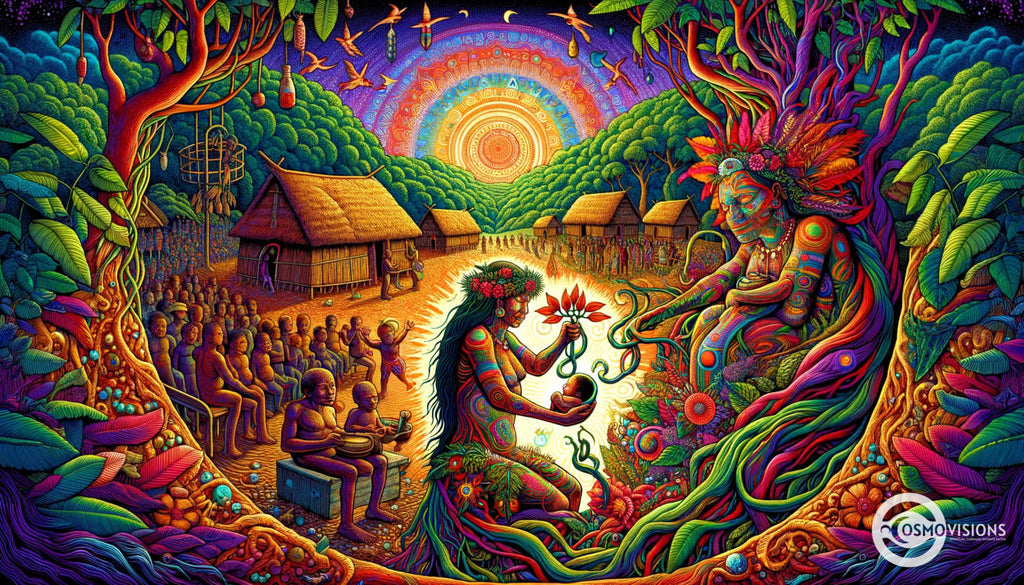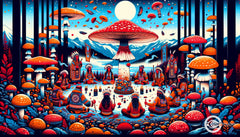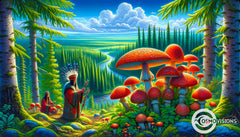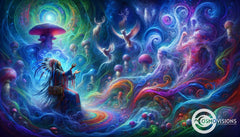Ayahuasca: A Portal to Visionary Amazonian Spirituality
Posted by Massimiliano Geraci

In the lush heart of the Amazon, a mystical brew known as Ayahuasca has been revered for centuries. This powerful concoction, often called the ‘vine of the soul’, intertwines two primary ingredients: the Banisteriopsis caapi vine and the Psychotria viridis leaves. This partnership of flora is not merely a random concoction but a sophisticated, time-honored recipe deeply embedded in the spiritual tapestry of Amazonian cultures.
The Banisteriopsis caapi vine, often referred to as the ‘spirit vine’, is the backbone of Ayahuasca. Its woody tendrils, stretching towards the sunlit canopy of the Amazon, are harvested with respect and understanding. Traditionally prepared by pounding, the vine contains harmine, harmaline, and alkaloids, which play a crucial role in the brew’s effects.
The second crucial component is complementing the vine, the Psychotria viridis leaves, known as ‘chacruna’ in Quechua. These leaves are the source of N,N-Dimethyltryptamine (DMT), a potent psychedelic substance. Combining these two plants is vital; neither is effective without the other in producing the visionary experience Ayahuasca is known for.
The Unique Pharmacological Interaction
The entwining of these two plants in Ayahuasca is a marvel of natural pharmacology, known as the Holmstedt-Lindgren interaction. This interaction is a key to unlocking the psychoactive properties of DMT. Ordinarily, when taken orally, DMT is neutralized by monoamine oxidase enzymes in the stomach. However, the harmala alkaloids in Banisteriopsis caapi inhibit these enzymes, allowing the DMT to reach the bloodstream and eventually the brain, where it exerts its powerful visionary effects.
Ayahuasca in Traditional Cultures
Cosmogonies and Shamanic Practices
Ayahuasca’s significance extends far beyond its physical ingredients. In the cosmogonies of Amazonian tribes, it is a bridge to the spiritual realm, a tool that shamans use to transcend the mundane world and interact with the spiritual. Ayahuasca ceremonies are deeply spiritual events where the shaman, or ayahuasquero, guides participants through the profound experiences that the brew induces.
These experiences are often described as transformative, providing insights into the nature of the universe and one’s consciousness. The shaman plays a critical role, using icaros or healing songs to navigate and shape the ayahuasca journey. This practice is steeped in a deep understanding of the interconnection between the physical and spiritual worlds and how Ayahuasca is a gateway between the two.
Ayahuasca and the Art of Healing
In the traditional societies of the Amazon, Ayahuasca is not only a spiritual sacrament but also a healing tool. Its therapeutic use is multifaceted, treating not just the body but the mind and spirit as well. Ayahuasca is used for diagnosing illnesses, purging negative energies, and, in some beliefs, communicating with ancestral spirits for guidance and healing.
The therapeutic effects of Ayahuasca are deeply rooted in the belief that many physical ailments have spiritual or psychological origins. The ayahuasquero, in a ceremony, might discern these underlying causes, offering both spiritual guidance and practical remedies. This holistic approach to healing is a testament to the deep wisdom of traditional Amazonian cultures and their understanding of the interconnectedness of health and spirituality.

The Mythological Landscape of Ayahuasca
Stories of Origin and Transformation
Ayahuasca holds a prominent place in the dense tapestry of Amazonian mythology, woven into the very fabric of indigenous narratives. These myths, rich in symbolism and meaning, often speak of Ayahuasca as more than a plant or a potion; it is a sentient being, a wise teacher, and a bridge to other realms.
One prevalent myth among several Amazonian tribes narrates the story of Ayahuasca as a divine gift. In this narrative, a spirit or deity presents the Ayahuasca vine to the people to understand life's and nature's mysteries. It is often depicted as a guide, leading shamans and spiritual seekers to the ancestral wisdom necessary for the balance and well-being of their communities.
Another common theme is transformation. Myths describe humans or gods transforming into the Ayahuasca vine or its companion plant, Chacruna, symbolizing the deep interconnection between humans and nature. These stories often serve as allegories for personal transformation, depicting Ayahuasca as a catalyst for spiritual awakening and self-discovery.
Ayahuasca's Role in Cultural Wisdom
Ayahuasca's role in the oral traditions of Amazonian tribes extends beyond mere storytelling. It is deeply ingrained in the cultural fabric, shaping their understanding of the world and their place in it. The brew is seen as a source of knowledge, offering insights into the natural world, human psychology, and the cosmos.
Shamanic traditions view Ayahuasca as a means to access ancestral knowledge and connect with the spiritual realm. It is believed to guide in navigating life’s complexities, offering practical and spiritual wisdom. This wisdom is not static but evolves with each generation as Ayahuasca reveals new insights and understandings.
The narratives surrounding Ayahuasca also play a critical role in preserving and transmitting cultural values. Through these stories, values such as respect for nature, the importance of community, and the pursuit of spiritual understanding are passed down through generations.

The Contemporary Globalization of Ayahuasca
Ayahuasca's Modern Rebirth
Ayahuasca has transcended its Amazonian roots in recent decades, capturing the global imagination. The brew's profound psycho-spiritual effects have drawn people from all corners of the world, leading to what some call the “globalization of Ayahuasca.”
This modern rebirth of Ayahuasca can be traced to a growing global interest in alternative spirituality and natural forms of healing. Ayahuasca ceremonies are now held far from the Amazon, in countries across North and South America, Europe, Asia, and Australia. These ceremonies often blend traditional Amazonian practices with elements from other spiritual traditions, creating a unique fusion that reflects the diverse backgrounds of the participants.
The spread of Ayahuasca has been subject to controversy. Concerns have been raised about the commercialization of the brew, the appropriation of indigenous practices, and the potential for misuse. Despite these challenges, the global spread of Ayahuasca has also led to greater awareness and appreciation of Amazonian cultures and their spiritual and medicinal knowledge.
Ayahuasca in Modern Healing and Spirituality
The integration of Ayahuasca into modern healing practices marks a significant shift. In Western contexts, Ayahuasca is increasingly viewed not just as a substance that induces altered states of consciousness but as a tool for psychological and spiritual healing.
Therapists and healers who work with Ayahuasca often describe its ability to facilitate deep emotional release, psychological insight, and the healing of trauma. This has led to a growing body of research into the therapeutic potential of Ayahuasca, with studies examining its effects on conditions such as depression, addiction, and PTSD.
The spiritual dimension of Ayahuasca is also gaining recognition in the modern world. For many, Ayahuasca ceremonies are a form of spiritual practice, offering a path to self-discovery, personal growth, and a deeper connection with the natural world. This contemporary spiritual use of Ayahuasca often emphasizes personal transformation, ecological awareness, and the quest for a more harmonious living.
In conclusion, the journey of Ayahuasca from the Amazonian rainforests to the global stage is a testament to its enduring power and relevance. As a bridge between ancient wisdom and modern lives, Ayahuasca continues to inspire, heal, and transform, challenging us to rethink our relationship with nature, the spiritual realm, and ourselves.
Respecting the Sacred: Ayahuasca's Ethical and Cultural Considerations
Cultural Sensitivity and Authenticity
In the realm of spiritual exploration, Ayahuasca stands as a profound testament to the indigenous wisdom of the Amazon. As it weaves into the global consciousness, it beckons us to approach with a deep cultural sensitivity and authenticity. This journey into the heart of Ayahuasca's tradition is not just about understanding a plant; it's about respecting a culture, a way of life, a spiritual heritage that has been nurtured over millennia.
Ayahuasca's journey from the Amazonian tribes to the modern world is a story of spiritual symbiosis. The Indigenous communities have long held Ayahuasca in high regard, not merely as a substance but as a sacred entity, a teacher, and a guide to the deeper realms of consciousness. It is essential to honor these roots, acknowledging the traditional practices and the spiritual context in which Ayahuasca has been used. This respect entails understanding the rituals, the songs (icaros), and the role of the shaman, ensuring these elements are not commodified or trivialized.
Ethical Harvesting and Sustainability
The surge in global interest in Ayahuasca has raised concerns about its sustainability. Ethical harvesting is paramount to ensure this sacred vine thrives in its natural habitat. Overharvesting not only threatens the ecological balance of the Amazon but also endangers the cultural integrity of the tribes for whom Ayahuasca is a cornerstone of spiritual practice.
Sustainable practices involve harvesting in a way that allows for regrowth and regeneration, ensuring that the spiritual legacy of Ayahuasca is preserved for future generations. This approach requires collaboration with indigenous communities, learning from their wisdom of living in harmony with the forest. It's not just about preserving a plant; it's about safeguarding a relationship between nature and humanity.
Ayahuasca's Future: Balancing Tradition and Modernity
As Ayahuasca approaches the global limelight, it encounters the challenge of balancing tradition with modernity. The evolving role of Ayahuasca in today's world is multifaceted, reflecting the complexities of cultural integration, spiritual exploration, and ethical considerations. This journey is not without its challenges. The sacred vine's popularity has led to a proliferation of Ayahuasca retreats, some of which may need to adhere to traditional practices and ethical standards.
However, these challenges also present opportunities. The global interest in Ayahuasca has opened doors for cross-cultural dialogue, creating a space where indigenous wisdom can be shared and respected. This exchange offers a chance to learn from each other, to blend ancient knowledge with modern insights, and to explore new dimensions of spiritual growth.
Ayahuasca's Contribution to Global Consciousness
The story of Ayahuasca is a beacon of spiritual resilience and transformation. As it traverses cultures, it carries with it the potential to deepen our collective understanding of spirituality. Ayahuasca invites us on a journey that transcends cultural boundaries, encouraging a dialogue rooted in respect, openness, and a shared quest for understanding.
In the tapestry of global consciousness, Ayahuasca weaves a thread of unity, reminding us of our interconnectedness with nature, each other, and the spiritual dimensions of our existence. It teaches us about the power of healing, the importance of introspection, and the beauty of a spiritual journey that honors tradition and innovation.
The story of Ayahuasca is not just about a plant; it's about a journey of the soul, a quest for meaning, and a celebration of the spiritual tapestry that unites us all. As Ayahuasca continues to inspire and transform across cultures, it calls us to embark on a path that respects the sacred, honors ancient wisdom and embraces the transformative power of spiritual exploration.






















